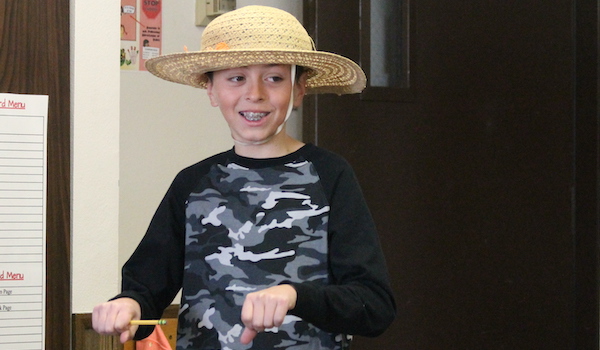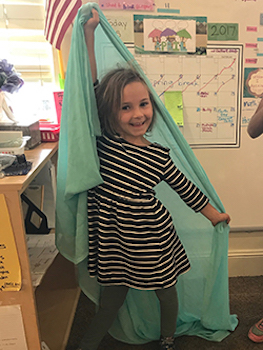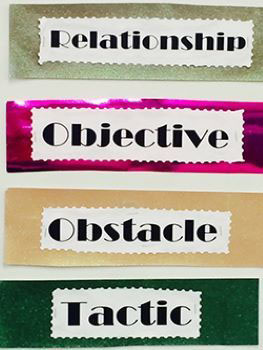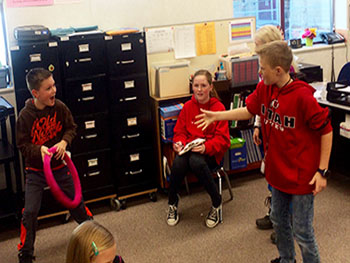SUBJECTS
GRADE
Show Results
Buy It Today

Lesson Summary
- Develop a unique name and use for a prop.
- Create and perform a commercial for the prop, demonstrating how it can solve problems.
Lesson Plan and Procedure
Lesson Key Facts
- Grade(s): 4, 5, 6
- Subject(s): Drama, English Language Arts
- Duration of lesson: 55 minutes
- Author(s): Haley Flanders Anderson
Note: Make sure you have your materials and enough room for the students to move. It is helpful if the students are already familiar with the six questions of storytelling: who, what, when, where, why, and how.
Warm-Up/Hook
Teacher: Stand in a circle. Let’s play a game called  “What is the scarf?” Here is a scarf. Yet once we begin the game, it will no longer be a scarf. We will pass it around the circle, giving everyone a turn to hold it. When it is your turn, without using any words, interact with it in a way that makes it appear to be something else. Anyone can call out what he or she thinks the scarf is. When someone answers correctly, pass the scarf to the next person. I will demonstrate.
“What is the scarf?” Here is a scarf. Yet once we begin the game, it will no longer be a scarf. We will pass it around the circle, giving everyone a turn to hold it. When it is your turn, without using any words, interact with it in a way that makes it appear to be something else. Anyone can call out what he or she thinks the scarf is. When someone answers correctly, pass the scarf to the next person. I will demonstrate.
Interact with the scarf. Here are some suggestions for ways to interact with the scarf: use it like a magic carpet, treat it like a hula skirt, use it like a towel, treat it like an animal, use it like a cape, hold it like a babe in your arms, show it like a bride, or wave it like a flag. Once the students answer correctly, pass the scarf to a student next to you. The game continues until everyone has had a turn.
Reflection
Teacher: What was easy about this game? What was difficult? How does this game relate to drama? Imagination is key when performing in drama. You can turn someone or something into whatever you like, as long as you fully commit your body and voice to the idea. Keep that in mind as you work with props today during our activity. Props are objects that actors handle in a play. It stands for “property.” Props can enhance a story and add depth to a performance.
Introduction
Teacher: What is the purpose of a commercial? It advertises products to a consumer. Compare that to an infomercial. Infomercials have even more information: price, phone number, and detailed examples of how the product works. They work hard to convince you to buy an object because of how it can solve problems. Today you will turn a random prop into a useful product and write and perform an infomercial for the product with a group.
Today you will turn a random prop into a useful product and write and perform an infomercial for the product with a group.
Infomercials are like miniature stories, since they have a strong story R.O.O.T. What does a root do for a plant? In the same way that a root grounds the plant to the earth, the R.O.O.T. of a story grounds it with enough detail. R.O.O.T. is an acronym that stands for relationships, objectives, obstacles, and tactics.
Define the following terms for the students and have them share examples from stories. Use visuals if you like.
- Relationships: Connections to people, places, and things
- Objectives: What you want
- Obstacles: Things that get in the way of what you want
- Tactics: Actions to try to get what you want
Instruction/Rehearsal
Teacher: Let’s watch a sample infomercial called “Hamper Hoops.” Look for how the prop helps people overcome obstacles.
Play the video (on YouTube or Hamper Hoops website) “Hamper Hoops.”
Teacher: Notice the question at the beginning: “What has kids racing to clean up their dirty laundry off the floor?” Just like a good story, this hooks the audience and gets them invested in the product and establishes the objective, the desire to have a clean room. The infomercial also shows relationships, or connections, between the kids and their rooms as being a boring chore and the kids interacting with Hamper Hoop as an answer to several obstacles. What were the relationships? A child and his or her parent, room, and clothes. Objective? A desire to have a clean room. What were the obstacles? A messy room and no desire to clean it. Another obstacle was that hampers are too large for the washing machine hole. Tactics? Treating the clothes as a basketball, making it more fun to clean a room. Another tactic is that this hamper is made of fabric, so it is easy to dump the clothes directly into the washer.
Teacher: Like this informercial, your group will develop a hook, two obstacles, and two tactics for your prop. You will also create a price and phone number, such as 1-800-HOOP. Then end with a catchy phrase, rhyme, or song, such as, “Let the fun begin, and throw it in.”
hook, two obstacles, and two tactics for your prop. You will also create a price and phone number, such as 1-800-HOOP. Then end with a catchy phrase, rhyme, or song, such as, “Let the fun begin, and throw it in.”
Teacher: As you write and rehearse, focus on descriptive words that answer the six questions of storytelling and provide an R.O.O.T. Focus on dialogue and words that engage our senses. Then consider how to animate your voice and body to create your character as you show us how to use your prop. Remember, even the narrator is a performer. Get creative and have fun!
Split the class into groups of four or five. Give each group a worksheet and a prop. Give them plenty of time to rehearse and complete the worksheet.
Activity/Performance
 Have students take turns performing their completed prop infomercials. It is best to number the groups on the sheet so the order is already decided. Remind them about the importance of being a respectful audience.
Have students take turns performing their completed prop infomercials. It is best to number the groups on the sheet so the order is already decided. Remind them about the importance of being a respectful audience.
Conclusion
Take time as a group to reflect on the activity and to reinforce standards that help students use effective techniques, descriptive details, and clear event sequences in their infomercials. Help students to make connections to other narratives that they will be asked to write or are currently writing.
Sample reflection questions:
- What was fun about the infomercials? What was difficult?
- Other than your own, what prop do you want to buy and why?
- What did this teach you about the importance of imagination? Storytelling? Establishing an R.O.O.T.?
- Can you identify the hook in any of the infomercials? How about the relationships and objectives?
- What were the obstacles and tactics? How did they enhance the infomercials?
Extensions
If you repeat this activity, consider how to integrate this process into other core subjects. Have the props be objects, math symbols, science topics, or social studies themes.
For example, to make math easier, you could have the prop be the plus, minus, multiplication, or division signs.
To teach the water cycle, use science topics such as precipitation, evaporation, condensation, dew, vapor, and water holding cells.
Geographic concepts such as latitude, longitude, hemispheres, landforms, and regions can be used as props to teach the of classification of physical geography.
Learning Objectives
- Establish a situation and characters who respond to actions.
- Use descriptions and concrete words.
- Provide a conclusion.
- Develop imagination.
- Write a script that focuses on the five Ws and how.
- Define roles and work in a group.
- Communicate character and story through physicality.
- Demonstrate audience skills.
Utah State Board of Education Standards
This lesson can be used to meet standards in many grades and subject areas. We will highlight one grade’s standards to give an example of application.
Grade 4 English Language Arts
- Standard 4.W.3: Write narrative pieces to develop real or imagined experiences or events using effective technique, descriptive details, clear event sequences, and provide a resolution.
- Orient the reader by establishing a situation and introducing a narrator and/or characters; organize an event sequence that unfolds naturally.
- Use dialogue and description to develop experiences and events or show the responses of characters to situations.
- Use a variety of transitional words and phrases to manage the sequence of events.
- Use concrete words, phrases, complex sentences, and sensory details to convey experiences and events precisely.
- Use appropriate conventions when writing including text cohesion, sentence structure, and phrasing.
Grade 4 Drama
- Standard 4.T.CR.1: Develop imagination to create artistic ideas and work.
- Standard 4.T.CR.3: Write or record simple dramas that include the five Ws of who, what, where, when and why.
- Standard 4.T.CR.4: Define roles, identify responsibilities, and participate in group decision making.
- Standard 4.T.CR.5: Create character through imagination, physical movement, gesture, sound and/or speech and facial expression.
- Standard 4.T.CR.7: Recognize that participating in the rehearsal process is necessary to refine and revise.
- Standard 4.T.P.3: Observe, listen, and respond in character to other actors throughout a scripted or improvised scene.
- Standard 4.T.P.4: Communicate meaning using the body through space, shape, energy and gesture.
- Standard 4.T.R.1: Demonstrate audience skills of observing attentively and responding appropriately.
Equipment and Materials Needed
- Technology to show the class the “Hamper Hoops” infomercial
- Props/toys (one per group)
- “Prop Infomercials” worksheet scene (one per group)
- Pencils
- Scarf
Additional Resources
- Hamper Hoops™ links
- Hamper Hoops™ YouTube infomercial: https://www.youtube.com/watch?v=JhANMJPQ-ak
Image References
- Image 1: Brenda Beyal.
- Image 2–3: Haley Flanders Anderson.
- Image 4: http://www.publicdomainpictures.net/view-image.php?image=88770&picture=outdoor-basketball-rim
- Image 5–6: Haley Flanders Anderson.

www.education.byu.edu/arts/lessons
 Download
Download